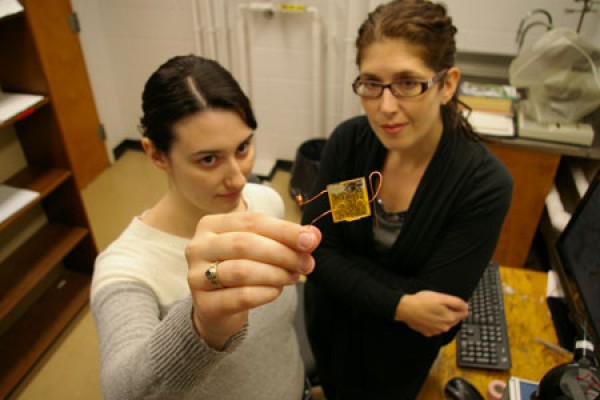A common method of treating babies born with jaundice is phototherapy, which involves bathing the infant in light from fluorescent bulbs, halogen quartz lamps, light-emitting diodes, and even fiber-optic mattresses.
Tricia Carmichael can see a day when those babies can simply be wrapped in a light-emitting blanket.
An associate professor in chemistry and biochemistry, Dr. Carmichael spends most of her lab time studying ways .gif) of making flexible and stretchable electronic devices. In a recent Advanced Materials journal cover article – whose first author was grad student Heather Filiatrault – Carmichael and her colleagues describe an emerging method used to make light-emitting devices designed to tolerate strain so that they can stretch, bend and wrap.
of making flexible and stretchable electronic devices. In a recent Advanced Materials journal cover article – whose first author was grad student Heather Filiatrault – Carmichael and her colleagues describe an emerging method used to make light-emitting devices designed to tolerate strain so that they can stretch, bend and wrap.
“There are all kinds of cool applications for this technology, but the idea is to be able to make it inexpensively,” Carmichael said.
The challenge with making stretchable conventional organic light-emitting devices, which rely on technology currently used in cell phones, cameras and digital media players, is the device complexity, Carmichael said. The display screens on those devices consist of thin film layers and each one needs to have an element of elasticity.
Carmichael’s approach has been to reduce the device complexity by using light-emitting electrochemical cells, which rely on materials that give off light when voltage is applied, sandwiched between electrodes. Along with her team, Carmichael developed a way to make a light-emitting material—an organometallic ruthenium complex—stretchable by blending it with an elastic silicone rubber.
“It’s actually a fairly simple idea but no one has ever really done it before,” said Carmichael.
Under lab tests to measure its “stretchability,” the team found the material could achieve about 25 to 30 per cent elongation before the device failed to emit light.
The concept is still in its infancy, but if developed it could have a wide range of potential applications from electronic display signs that could wrap around the corners of buildings to such health applications as light therapy used for healing wounds or activating certain chemotherapy drugs, Carmichael said.
Watch a video describing the process.

